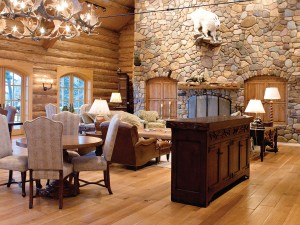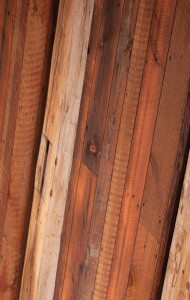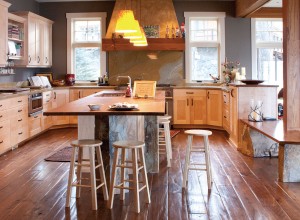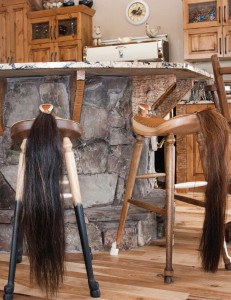BUCKEYE HARDWOODS
Across the country, more homeowners, builders, designers, and architects are opting for a rustic, traditional look when designing new construction. The use of antique and reclaimed lumber in the building process has exploded in the past ten years. However, in today’s economic climate, nickels and dimes matter more than ever. Not only is producing reclaimed materials a labor-intensive and costly process, but there is a limited supply; both factors lead to higher prices. “Cost is always an issue; whether a project budget is $300,000 or $3,000,000, in the end every job is constrained by a budget,” says Buckeye Hardwood & Lumber Company owner, Hank Adams. “Getting the desired look is important, but keeping the job under budget is often more important. We can help consumers get the rustic look they want without breaking the bank.”
The development of the antique and reclaimed market over recent years is a result of several different societal changes. Over the last two decades the building industry has seen a huge movement towards reusing and recycling older materials in construction as the push for sustainability with natural resources has grown. At the same time, barns and buildings that were constructed over the last two to three hundred years began to deteriorate and to fall down as landowners shifted away from agricultural use of their land. Rather than waste the barn materials, landowners began looking for someone willing to tear the barn down and reuse the materials. They were met with the open arms of enterprising individuals and businesses that saw this as an opportunity to promote the use of recycled products, to meet the needs of the landowners and to provide a rustic “Old World” look to clients.
“AMERICAN HARDWOODS ALWAYS HAVE BEEN AND CONTINUE TO BE AN EXTREMELY SUSTAINABLE PRODUCT.”
–HANK ADAMS, OWNER
However, the cost of reclaimed materials can make it difficult to use on new projects. Not only is it a labor-intensive and costly process to tear down old buildings, but there is also a limited supply of buildings available. In addition, antique materials often need to be power-washed to remove lead-based paint and also kiln-dried to prepare for interior use. “Use of reclaimed materials in a building project can often be cost prohibitive,” Adams explains. “Antique wood is a limited commodity. You can’t go back 200 years and build more barns. Every barn or old building that is torn down is one less source for reclaimed lumber. It also takes a lot of time and expense to tear down a building without ruining the materials and to prepare the products so they are safe for consumer use. That being said, we have several ways of distressing lumber to mimic reclaimed lumber, and it’s often indistinguishable from the ‘real’ thing.”
 Today, businesses such as Buckeye Hardwood & Lumber Co. not only provide customers with the option of “real” antique materials, but also provide less expensive alternatives. “Adding texture to lumber materials, including flooring, moulding, and cabinet materials can give you the appearance of reclaimed lumber without the cost. We have the ability to provide hand-scraped, circle-sawn, wire-brushed and band-sawn textures as well as any number of combinations of these textures.” In 2004, Adams designed and built his own machine to put a circle saw texture onto materials. Adams also worked with several different high-quality suppliers, including Allegheny Mountain Hardwood Flooring and Sheoga Hardwood Flooring, as they developed texturing programs for a variety of different flooring products. “At this time the sky is the limit as to the rustic looks we can provide at a lower overall expense to our customers.”
Today, businesses such as Buckeye Hardwood & Lumber Co. not only provide customers with the option of “real” antique materials, but also provide less expensive alternatives. “Adding texture to lumber materials, including flooring, moulding, and cabinet materials can give you the appearance of reclaimed lumber without the cost. We have the ability to provide hand-scraped, circle-sawn, wire-brushed and band-sawn textures as well as any number of combinations of these textures.” In 2004, Adams designed and built his own machine to put a circle saw texture onto materials. Adams also worked with several different high-quality suppliers, including Allegheny Mountain Hardwood Flooring and Sheoga Hardwood Flooring, as they developed texturing programs for a variety of different flooring products. “At this time the sky is the limit as to the rustic looks we can provide at a lower overall expense to our customers.”
At the same time, Adams feels that using newly harvested lumber rather than reclaimed lumber does not change the impact on the environment. “One reason there has been a push for using reclaimed lumber in products is to reduce the carbon footprint of a building project, but with American hardwoods –HANK ADAMS, OWNER
being such a sustainable resource, this is often a moot point.” For many reasons, American hardwoods are considered as “green or greener” than many reclaimed options. The energy that goes into tearing down a barn and preparing the materials for reuse is often the same amount or more than the energy that goes into harvesting and producing new materials. Also, one of the same social changes that helped bring about the growth of the antique materials industry also brought about the prolific re-growth of American hardwood forests. “At the beginning of the 1900s much of the land in the Midwestern and Eastern United States had been cleared for agricultural use. As our society shifted away from family farming, much of the former farm land has naturally reseeded with hardwoods and is forested once more. American hardwoods always have been and continue to be an extremely sustainable product.”
The look that antique lumber can provide is often felt to be “unmatchable,” but Adams has spent years striving to perfect different products that are nearly indistinguishable from the actual reclaimed materials. “Take American Chestnut, for example. American Chestnut was hit by a blight brought into the United States with the Chinese Chestnut and is no longer able to reproduce, thus making it essentially extinct. While I am hopeful in my kids’ lifetime we will see American Chestnut growing and sustaining itself in the forests of the United States again, the only way American Chestnut is currently available is on the antique market.” Adams instead recommends consumers consider using Butternut, a member of the Walnut family, as a more cost-effective alternative to American Chestnut with an extremely similar appearance. Adams also recommends that consumers use antique products in a way that might be more affordable. “There is no reason you can’t use one antique beam as a feature piece such as for a fireplace mantel. Using specific featured areas for your antique products rather than for your entire project is an easy way to cut your costs without eliminating the idea altogether.”
 “The antique market is a great market and we love being able to help builders and homeowners utilize reclaimed lumber in their building projects, but there are some times that the cost of the materials just won’t fit in the budget, and we have to look for alternatives,” Adams reflects. “Ultimately it comes down to this; we can generally help our customers find the look they want but often at a fraction of the price, all while providing them with a product that has minimal impact on our natural resources. That is a wonderful feeling and something we are proud to be able to do.”
“The antique market is a great market and we love being able to help builders and homeowners utilize reclaimed lumber in their building projects, but there are some times that the cost of the materials just won’t fit in the budget, and we have to look for alternatives,” Adams reflects. “Ultimately it comes down to this; we can generally help our customers find the look they want but often at a fraction of the price, all while providing them with a product that has minimal impact on our natural resources. That is a wonderful feeling and something we are proud to be able to do.”
For more information, call Buckeye Hardwood & Lumber Co. at 406.726.2008, visit www.buckeyehardwoods.com, or www.facebook.com/buckeyehardwoods.

